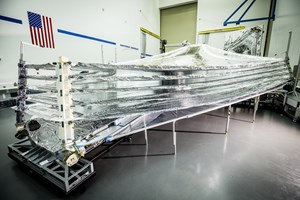Aug 13 2015
The first of the five sunshield layers that will make it possible for NASA's James Webb Space Telescope to image the formation of stars and galaxies created more than 13.5 billion years ago, was delivered to Northrop Grumman Corporation's Space Park facility April 24.
 The sunshield of NASA's James Webb Space Telescope is the size of a tennis court. It is constructed with five individual layers of Kapton, which effectively reduces the temperatures between the hot and cold sides of the observatory by approximately 470 degrees Fahrenheit. (Photo Credit: Northrop Grumman/Alex Evers)
The sunshield of NASA's James Webb Space Telescope is the size of a tennis court. It is constructed with five individual layers of Kapton, which effectively reduces the temperatures between the hot and cold sides of the observatory by approximately 470 degrees Fahrenheit. (Photo Credit: Northrop Grumman/Alex Evers)
Northrop Grumman is designing the Webb Telescope's optics, sunshield and spacecraft for NASA's Goddard Space Flight Center, in Greenbelt, Maryland. Innovative sunshield membranes are being designed and manufactured by NeXolve Corporation, a subsidiary of ManTech International Corporation of Huntsville, Alabama.
The Webb Telescope will be the largest telescope in space. Its sunshield, which is the size of a tennis court, is constructed with five individual layers of Kapton, which effectively reduces the temperatures between the hot and cold sides of the observatory by approximately 570 degrees Fahrenheit. Each successive layer of the sunshield is cooler than the one below, preventing the interference of background heat with the telescope's infrared sensor.
"Through extensive testing we have proven that the innovative sunshield design works," said Jim Flynn, Webb sunshield manager, Northrop Grumman Aerospace Systems. "We are thrilled to receive the first flight layer from NeXolve as we prepare for 2018 launch."
NeXolve is manufacturing the other four layers and will individually shape-test each to ensure they meet requirements. This delivery to Northrop Grumman signifies the beginning of final flight hardware completion for the sunshield. Next, Northrop Grumman will integrate the final flight layers into the sunshield subsystem, to conduct folding and deployment testing as part of the final system validation process.
"Our entire ManTech team has worked diligently to achieve the manufacturing completion of the first sunshield layer and successfully deliver it to our partners at Northrop Grumman," said Greg Laue, sunshield program manager, NeXolve. "Delivery of the first flight layer is the culmination of years of development and manufacturing and we are thrilled to have accomplished this major program milestone."
The Webb Telescope is the world's next-generation space observatory and successor to the Hubble Space Telescope. The most powerful space telescope ever built, the Webb Telescope will observe distant objects in the universe, provide images of the first galaxies formed and see unexplored planets around distant stars. The Webb Telescope is a joint project of NASA, the European Space Agency and the Canadian Space Agency.